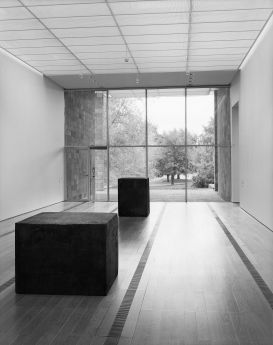
Weight and measure
"I want to make the volume of the space tangible, so that it is understood immediately, physically, by your body; not so that the sculpture is a body in relation to your body, but that the volume, through the placement of the sculptural elements, becomes manifest in a way that allows you to experience it as a whole."1 Richard Serra
Richard Serra's sculptures are particularly known for how they affect the perceptions and physical experiences of the viewer in a way that is crucial to their meaning. The massive size of his sculptures allows viewers to walk in and around them, encountering them from multiple perspectives. Serra's subtle plays with scale and positioning often produce tricks of perception.
In Serra's The Consequence of Consequence (2011), two 8.5-ton massive steel blocks stand opposite each other.2 They are the same dimensions but one is laid horizontally and the other vertically, so that their height, length, and width are positioned differently. This discrepancy in configuration leads the viewer to perceive them as having different proportions-perhaps even different weights and volumes. Opposite each other, the blocks create a force field of two poles with tension in between. But they also imply repetition, the possibility of a field in which blocks go on and on.
The blocks of The Consequence of Consequence are constructed of weatherproof forged steel. Because the internal grain of the metal is altered in the forging process, it produces pieces with more strength and weight than casting. Serra has said about this choice: "Forging is the most compressed, compacted way, so to speak of making a patty-cake. More molecules are pressed into the same space than in casting..." In addition to their dense appearance, the surface is different: "They've got the afterglow of being in the oven."3 About a similar work in 1992 entitled Weight and Measure, Serra said that he also chose the shape-rectangular-in order to convey weight. He didn't want them to "be read as slices, cuts, lines, plates; I rather want to make the weight perceptually accessible."4
1 Serra, Writings/Interviews, p. 273-4.
2 Fondation Beyeler, Brancusi Serra Information Sheets.
3 Serra, Writings/Interviews, p. 264.
4 Serra, Writings/Interviews, p. 272.
Preguntas
- Look carefully at The Consequence of Consequence. What do students notice? How would they describe the shape of the sculptures? How would they describe the configuration in space? How would they compare the sculptures to each other?
- Ask them to imagine walking around the sculptures. List the words that come to mind as they imagine looking at the sculptures from all angles.
- These pieces are made with forged steel. Ask students what they know about the ways that metal can be formed. Describe the process of forging steel in which, usually, a metal is heated in an oven and then hammered manually or with machinery into a desired shape. Ask students to compare this process to the more traditional metal sculpture process of casting, in which molten metal is poured into a mold while in a liquid state. How do the processes involve the artist in different ways?
- Compare these processes to other sculpture-making methods students know about. Which process do they think they would prefer to work with as an artist and why?
- Think together about the title, The Consequence of Consequence, based on a previous work titled Consequence (1977) consisting of two rectangular blocks subtly differentiated: one wider and shorter, the other taller and thinner.
- Why do students think Serra might have titled the artwork this way: The Consequence of Consequence? What possible meanings and associations does this title generate for you? About the work, a curator has written: “Within this space of indeterminacy, body, mind, and material are activated, triggering a seemingly endless series of different perceptions-consequences of consequences.”1 How does this statement help them make sense of the title, if at all?
- Ask students to give the artwork their own title. Why did they choose their title?
1 Brancusi SerraInformation Sheets. Fondation Beyeler, 2011.
